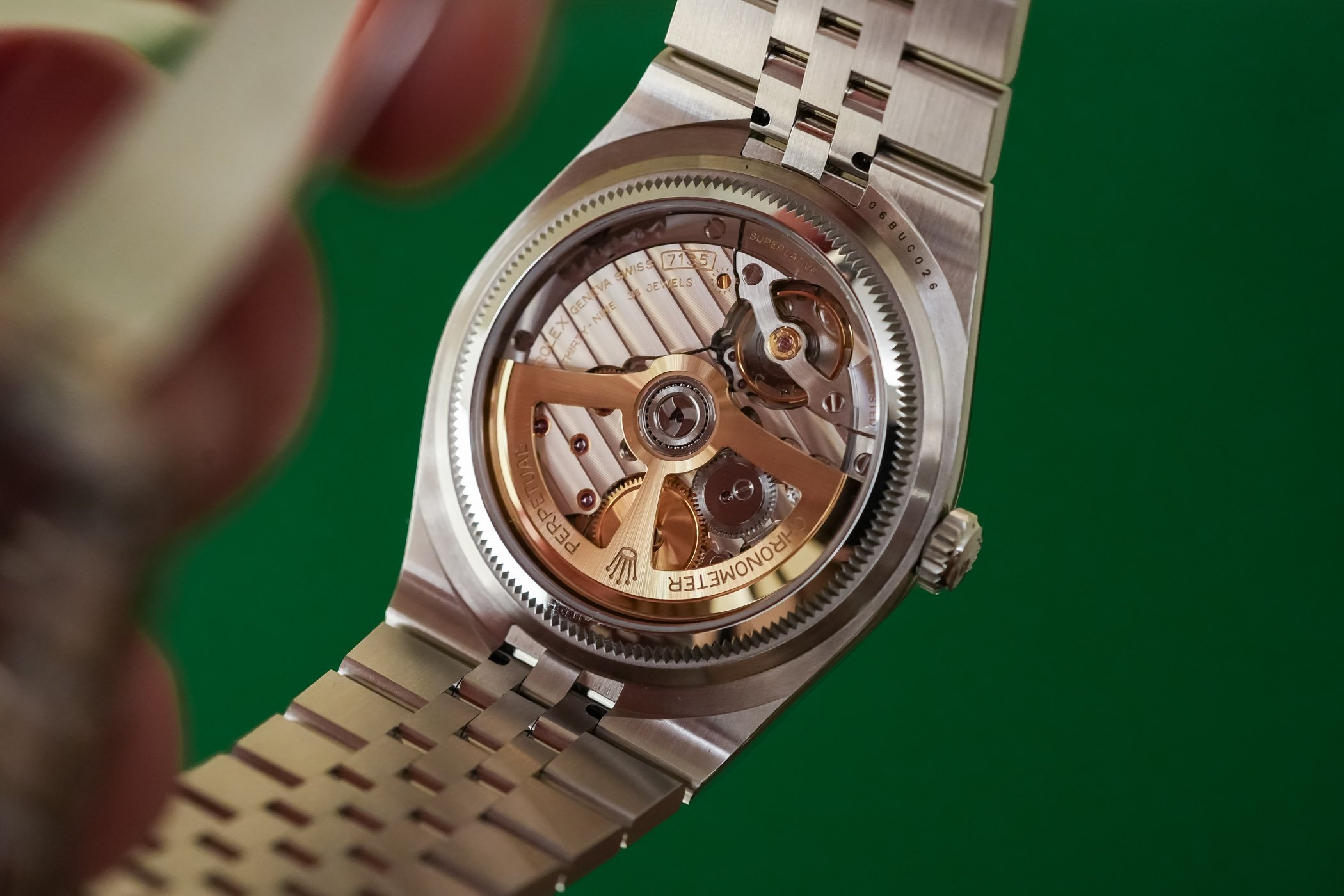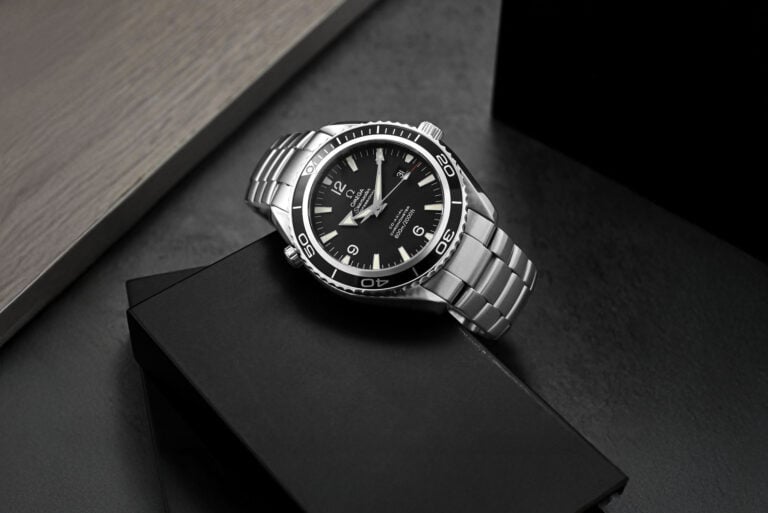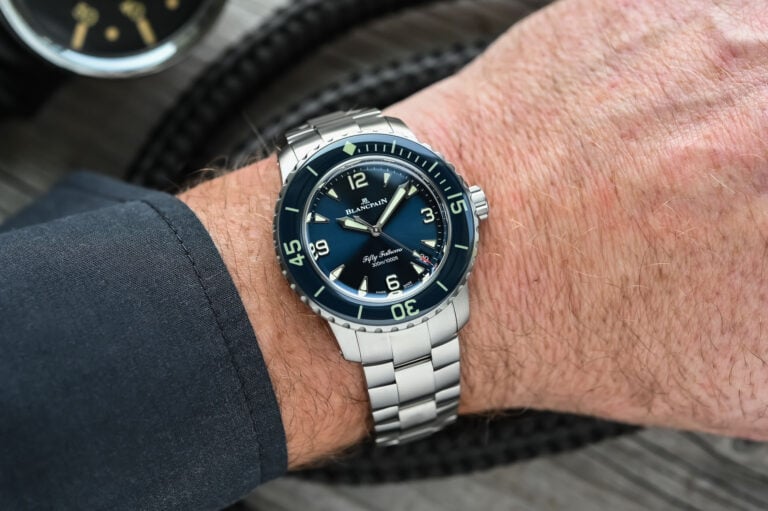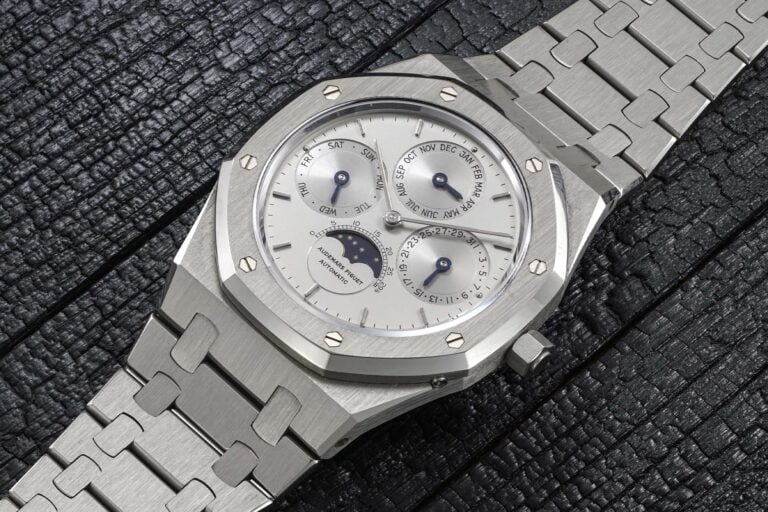Deciphering the Revolutionary Rolex Dynapulse Escapement and the Calibre 7135
Rolex has created an entirely new type of escapement, and we explain everything about it.

Rolex has changed… Not marginally, but significantly. We knew the brand was capable of being rather unpredictable and capable of bold creative moves, such as bubble-decorated dials and watches with a guilloché pattern. The days when Rolex simply revamped a collection every 10 years by implementing incremental upgrades and releasing new dial colours every two years are gone. Under the leadership of Jean-Frédéric Dufour (JFD, as employees call him internally), the brand has been transformed. What we have witnessed at Watches and Wonders 2025 goes many steps further than traditional innovation. We’re not specifically speaking about the Land-Dweller as a watch, even though it carries great importance, but what beats inside the watch. There is indeed a true watchmaking revolution inside the calibre 7135 named the Dynapulse escapement. And we’ll try to explain everything about it.
Before we publish our hands-on article with the Land-Dweller (which will be done in the coming days), we wanted to dive deep into its movement, something that I’m not shy of calling revolutionary: the Dynapulse escapement. Let’s first briefly state what Dynapulse isn’t and what it is. Contrary to previous beliefs, which rose from findings in patents filed by Rolex a few weeks before Watches and Wonders 2025, the Dynapulse escapement is NOT a natural escapement. There have been some misunderstandings here due to the complexity of this innovation. We decided to ask a master watchmaker, Karsten Fraessdorf, to give his views on this new type of escapement.

So what is the Dynapulse escapement all about? Well, two things in particular: high-frequency and high-efficiency. In a very succinct description, Dynapulse is a groundbreaking, highly innovative, yet surprisingly simple new type of escapement. It can’t be compared to anything else. It is not a Swiss lever escapement, which Rolex already drastically improved with its Chronergy escapement launched in 2015. It is not a natural escapement as per Breguet’s concept, or later adopted by George Daniels, Derek Pratt or Laurent Ferrier. It is not identical to the Dual Ulysse escapement. It is something entirely new and particularly impressive in the context of a movement produced on an industrial scale by a watchmaking company that’s usually known to focus on relatively conservative solutions and reliability. And all the more coming from Rolex, the Dynapulse escapement is staggering. For those who said that Rolex wasn’t a proper watchmaker, here’s your counterargument.
In the words of Frank Vernay, head of movements at Rolex, Dynapulse is a “sequential distribution escapement (…) that offers high energy efficiency, approximately 30 per cent more than a conventional Swiss lever escapement, while taking up no more space”. It is, in more technical terms, a double-wheel, indirect-tangential impulse escapement made almost entirely from silicon, using highly complex yet surprisingly organic geometry for its two wheels and focused almost entirely on efficiency. The whole idea was to be able to move up to a 5Hz frequency – which is, all things considered, better for accuracy – while not consuming more energy and not taking more space than a more traditional Chronergy escapement beating at 4Hz.

This novel escapement alone is protected by seven patents. “Much of the work concentrated on simplifying the shape of the wheels and the impulse rocker so that these components could be made out of silicon. Fitting such a complex mechanism into the same space as a conventional Swiss lever escapement constituted a real technological challenge, as did the production and pre-assembly of the small components in silicon,” says Vernay.
What makes Dynapulse different from a natural escapement while still retaining a double-wheel architecture? As we explored in this article about the natural escapement in Laurent Ferrier’s watches, this solution was imagined (as always) by Abraham-Louis Breguet to compensate for the flaws of the Swiss lever escapement – low efficiency, need for lubrication, high level of friction, but easy to produce and self-starting – which is still in use in about 99% of mechanical watches. Breguet’s idea was to combine the self-starting capacity of Mudge’s 1755 lever escapement with the frictionless operation of another solution, the detent escapement. Breguet’s vision was to create an escapement incorporating two escape wheels. The escapement is said to be “natural” because the impulses are transmitted from the escapement wheels to the balance wheel as directly as possible. There is no sliding friction, which is one of the main weaknesses of the Swiss lever escapement, and they do not require lubrication. Operating in alternation, these give two impulses per oscillation, one in each direction. Breguet faced major issues in the development of the natural escapement, mostly related to the lack of technology. However, the natural escapement returned to high-end watches recently, but only on an artisanal scale.

The reason why the Dynapulse escapement isn’t “natural” is fairly simple. It does not give a direct impulse to the balance; only one of the two wheels is actually connected to the gear train. As the first escape wheel is powered by the silicon-made fourth wheel, the other is driven by the motion of the first. Also, Dynapulse’s wheels don’t produce a direct impulse on the balance. Instead, they are connected to an impulse rocker, which in turn gives impulse to the balance.
The impulse rocker is used to control the locking and releasing functions, thus giving the impulse to the balance. There are two escape wheels, one of which is inoperative every other half-oscillation and simply has to be dragged along and then act on an anchor. According to watchmaker Karsten Fraessdorf, “accelerating two escape wheels that have to catch up with the balance wheel at its fastest? That’s like Usain Bolt with a 10-kilo backpack since the anchor is the biggest energy waster in wristwatches”. So why would this whole concept make sense?
Fraessdorf adds that the genius of Dynapulse lies partially in the geometry of the wheels. “Instead of the usual 15 or 20 teeth, with a further upward trend in development, Rolex chose to have only 6 teeth. This results in a pitch of 60 degrees compared to the usual 24 or even just 18 degrees,” he said to us, adding that “this enabled the designers to make the escape wheels extremely small in relation to the balance wheel diameter. Not only does this drastically reduce their own weight, but it also significantly reduces centrifugal forces, i.e., the inertia of the wheels. The price for this was the implementation of an otherwise unusual fifth wheel in the gear train, but the disadvantage of the additional friction is negligible compared to the acceleration capability of the escape wheels, which has increased enormously.” He ended up with a very simple analogy: “Usain Bolt’s backpack has disappeared. Instead, he received an acceleration aid in the starting block.”
So once again, Dynapulse is all about efficiency, and the fact that this new escapement running at 36,000 vibrations per hour does not consume more energy than the Chronergy escapement of the Rolex calibre 7140 found in the Perpetual 1908 (the same base movement) and running at only 28,800 vibrations per hour, is impressive. In both, the power reserve is rated at approximately 66 hours.
Of course, this isn’t the whole story. Fraessdorf adds that the surfaces and shape of the teeth also play a role. By using a DRIE process, it was possible to produce a polished tooth tip, as well as an impulse surface that’s convex rather than flat, once again limiting friction – in fact, there’s no sliding friction anymore, as in a lever escapement, but instead a rolling motion with the contact surfaces that press against each other rather than slide. The results are surprising organic shapes for the teeth. Combined with major upgrades on the anchor, as well as on the locking and unlocking moments, this results in a highly efficient escapement that could virtually run without oil, yet Rolex emphasised the use of “oil rather than grease for lubrication. Applied using a curved precision needle, the oil is dispensed on a scale of nanolitres”.
This is for the escapement part, also known as the Dynapulse escapement. But there is more to the calibre 7135, with some impressive technology also found on the rest of the regulating organ. For instance, the balance staff is made from white ceramic that not only provides extreme strength but is also polished on a nanometric scale. This polishing is carried out to prevent any fissures or damage in the event of impact while creating a perfectly smooth surface finish that once again adds to the movement’s efficiency. This material is also paramagnetic – Rolex doesn’t make any claims regarding the overall magnetic resistance of its movement, but we can assume that it’ll survive pretty high magnetic fields – potentially to METAS levels, but the Master Chronometer certification is only implemented at Tudor.
Then, there’s the balance itself, which retains a classic free-sprung nature but is made of “optimised brass”. Once again, patent pending (EP4399575A), the material used in place of traditional Glucydur (beryllium, copper and iron alloy), is a lead-free brass known as CuZn21Si3P. It is said to have greater anti-magnetic properties. Finally, the calibre 7135 is equipped with the brand’s Syloxi hairspring, made of silicon. It isn’t a first for the brand and has been seen in various ladies’-sized models as well as in the calibre 7140 of the 1908 Perpetual.
Yet, due to the novel nature of the escapement and the 5Hz frequency, the hairspring had to be redesigned and recalculated. It features reshaped coils, which are now thicker to confer greater rigidity. Once again, its geometry is highly specific, with two anchor points under the balance bridge. This also meant connecting the ceramic balance staff to new, optimised Paraflex shock absorbers – one at each end of the staff, at the pivots – that include an enhanced leaf spring that ensures optimal repositioning of the staff after a shock.
In conclusion, and to quote Karsten Fraessdorf, “Rolex has made a brilliant move with the Dynapulse escapement. Who would have thought that the lever escapement, a standard in mechanical wristwatches for over 250 years, could be turned on its head like this and significantly improved in the process?” Above all the technical aspects, it’s the elegance of the solution that must be applauded. Behind its apparent simplicity, the Dynapulse escapement is the result of years of research and development and is extremely refined in the details of its architecture and geometry. Mechanical innovation and watchmaking are very much at the centre of attention at Rolex, which seems to liberate itself from traditionalism and constraints. And what’s more impressive is that we are talking about large-scale watchmaking, not prototyping. “Rolex doesn’t use new technologies to copy the old, but rather sets its own new boundaries,” concludes Fraessdorf.
For more details, please visit rolex.com.









19 responses
Grand Seiko evolution 9 is better than this
@Alfred – could please elaborate on why you think Grand Seiko’s Dual Impulse Escapement is better? Interested in reading your arguments. Genuinely.
Longer power reserve but maintaining the same frequency, plus much nicer dial. I just think Grand Seiko deserves more credit for what the brand has become. The new Rolex movement uses similar concept, but GS is already a few years ahead of them with different iterations of the movement already.
@alfred But does it match how thin this new Rolex movement is? Maybe not so hard to have a longer power reserve if you make a much thicker movement…
@Alfred As a massive Seiko fan, I absolutely disagree, firstly the EVO 9 has a great movement, but the dual impulse escapement has technical disadvantages compared to the dynapulse, mainly due to its use of traditional materials instead of silicon, and lack of entire elimination of friction. My main issue however is the watches themselves, far too big, bar too thick. When Seiko offer a 36mm watch at under 10mm I might go back to them
Nice to see a genuine innovation from Rolex. If it makes it’s way into a more attractive watch I could be interested.
@Alfred
Let’s be clear: Evolution 9 isn’t a movement or escapement, it’s a collection that spans multiple calibers, both mechanical and Spring Drive. And honestly, I’ll get excited when Grand Seiko figures out how to make a case under 10mm thick. That new chronograph they dropped at Watches & Wonders? 15mm… seriously? Come on GS, you’re better than this.
A more philosophical aspect is the compatibility of high tech materials(like Silicon) in modern mechanical watches. Traditionalists where in for traditional materials and had massive objections that Silicon offers a sustainability in terms of Horology.
Seems to me that Rolex gave their reply to this dilemma and it will be interesting how the Holy Trinity and other manufacturers react
@Alfred – First of all, we’re here exclusively talking movement, not collections or watches. Evolution 9 is a collection of timepieces. So, if we’re moving back to movements and escapements, meaning the 9SA5 and the Dual Impulse Escapement, there’s certainly no reason to denigrate what GS has been doing. It is a great escapement, quite efficient and known to add precision. Yet, we’re not talking about the same typology of escapement. And also, there is indeed 80 hours of power reserve, yet in a much larger movement with two barrels. All things considered, it’s hard to compare two watches, and both have their advantages. Rolex however can encase this calibre 7135 in 36mm watch with a thickness just above 9mm. GS for now can’t do that due to the large dimensions of the movement. So regarding efficiency and compactness, which are the main objective of the Dynapulse, Rolex seems to have found a pretty impressive solution. Also, anti-magnetism is here potentially far greater than GS… that being said, Rolex does not provide specific levels of antimagnetism, but the materials involved certainly indicate a high level.
@Jonathan Quayle Higgins – Silicon has long been adopted by Swatch Group, Rolex and Patek Philippe, three consortiums that were behing the patents for the silicon hairspring (with Ulysse Nardin). Patek watches are for a large part already equipped with silicon escapements and hairsprings. The reason why AP and Vacheron are not using silicon now is probably not philisophical but has to do with the fact it remains difficult for them to use it due to the patents – as we explained here https://monochrome-watches.com/in-depth-the-future-of-silicon-hairspring-and-silicon-technology-in-watchmaking-with-expired-patent/
@Brice Goulard,
please correct me if I am wrong – as far as I am aware PP uses Silicon in hairsprings only ( in regular models) – similar to Rolex.
Now making virtually ( I am exaggerating here) the entire escapement out of Silicon is a gamechanger imo and a very bold move for Rolex. They go High Tech here without compromises!
I don‘t think that Omega‘s tech moves have much of a relevance for Rolex – sadly but true
Can someone compare Natural escapement with Dynapulse? Which is better in terms of efficiency and lubrication or ease of maintenance? The Dynapulse requiring a tiny amount of oil sounds potentially more of a headache to service?
And here I was thinking I miss when Rolex made easy to service and reliable movements before the 32xx…and now Rolex comes out with something even more complicated than Chronergy. lol
@Supes Critic – well, we’d love to do that. That would require to have two watches in our hands, some measuring equipment and a trained watchmaker. And even with that, the best way to compare would be to fit the same movement with the different regulating organs… Not easy as you can imagine. As for maintenance, most watches with a proper natural esapement are produced at artisanal scale by independent watchmakers, while Dynapulse comes from Rolex… I wouldn’t be too worried about servicing the Land-Dweller, as long as the service is done by an authorised Rolex service center.
@Jonathan Quayle Higgins – indeed, I was getting ahead of myself. PP does use silicon hairsprings in regular production watches, and the silicon escapement is found in Advance Reaseach models.
DEPOIS DESTA DEMONSTRAÇÃO E EXPLICAÇÃO UMA PERGUNTA CURIOSA;QUAL A PRECISÃO DIÁRIA DESTA PARAFERNÁLIA E LABIRINTO DE PEÇAS??
TELMO ROGÉRIO SECCO.
Watches have been made for over 100 years without silicon and ceramic parts with no issues that prevent enjoyment of your watch OR its longevity. We must remember that a lot of this new technology is about upselling. Simililar to the TV industry for example (4k, OLED, QD-OLED, QNED) etc. No one was or crying out for Silicon hairsprings or ceramic parts, modernising for the sake of modernising. The also encourage replacment rather than repair culture, silicon hairsprings and parts are more prone to shattering if you unlucky watch is dropped or even during a service. My dad is a watch repairer and he HATES silicon parts. He calls them a fad nothing more or less. I admire the the know how of course, clever people, but I dont really understand the facination with putting it into watches, rather than designing a nice looking dial for example, which the land dweller lacks IMO.
@Brice Goulard thanks for a great article. With respect to your comments regarding the reasons for more brands, like VC not using silicon parts in their escarpments, Zenith has been using pallet fork and escape wheel for years and their are currently implemented in their 3600 caliber series, so is it really a patent issue or potentially something else?
Separately, on the topic of Zenith and innovation, with their caliber 3600 and the use of silicon fork and escape wheel (where most of the friction is) they were able to increase power reserve, make the movement more antimagnetic. The lighter and more efficient escape mechanism also allows for the chronograph to be driven directly from the escape wheel (vs 4th wheel, as is usually the case) and of course the el premier has always been beating at 36,000 vph. Would be great to hear your thoughts and maybe a comparison or a write up on Zenith caliber. Thanks
@SK – Thanks for the comment and a very quick answer regarding the patent. It only concerns the silicon hairspring, not silicon parts in general, which have been used by many other brands in other critical parts of the escapement. However, if you look closely, you’ll see that very brands are actually using a silicon hairspring, which is what the CESM / Rolex / Patek / Swatch patent is all about.